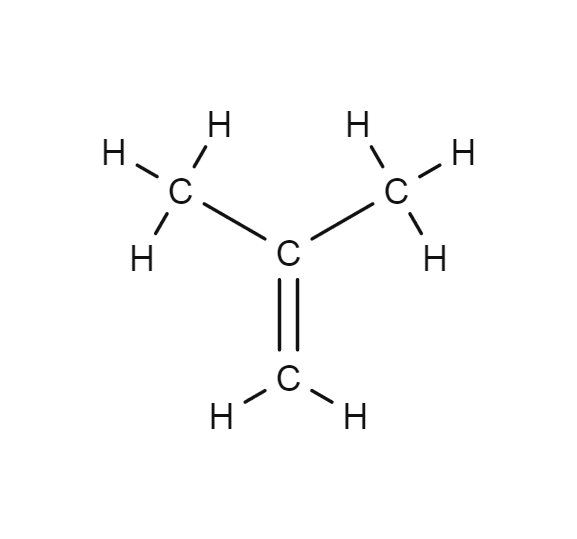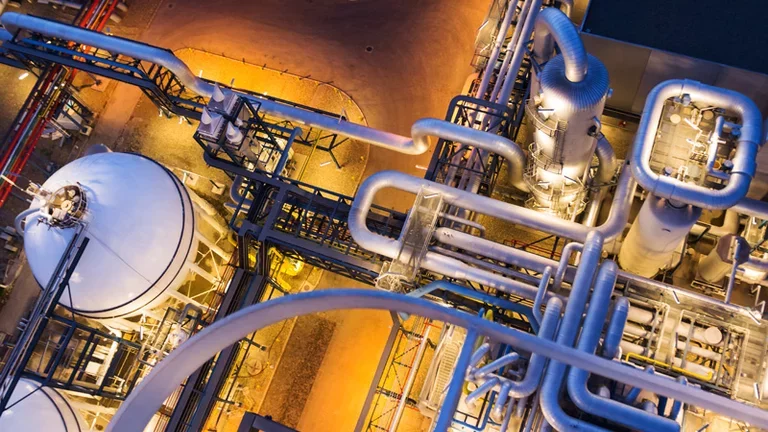
Isobutene
- C4H8
- CAS Number 115-11-7
- UN1012 (gas)
Click & drag to move the 3D molecule
Liquid / Gas Volumes
Calculate the volume or mass of a quantity of gas or liquid
Liquid Phase
At boiling point at 1.013 bar
Gas Phase
In standard conditions (1.013 bar, 15°C)
Physical Properties
Molecule phase diagram showing the transition phases between solid, liquid and gas as a function of temperature and pressure
-
- Molar mass 56.106 g/mol
- Content in dry air /
-
Critical Point
- Temperature 144.75 °C
- Pressure 40 bar
- Density 234.75 kg/m³
-
Triple Point
- Temperature -140.75 °C
- Pressure 6.449E-6 bar
Pressure 1.013 bar
| Latent heat of fusion (at melting point) | 105.714 kJ/kg |
| Melting point | - 140.34 °C |
Pressure 1.013 bar
| Boiling point | - 7 °C |
| Latent heat of vaporization (at boiling point) | 391.634 kJ/kg |
| Liquid density (at boiling point) | 626.479 kg/m3 |
| Compressibility factor Z | 9.6136E-1 |
| Cp/Cv ratio γ | 1.1329 |
| Gas density (at boiling point) | 2.683 kg/m3 |
| Gas density | 2.6032 kg/m3 |
| Gas/(liquid at boiling point) equivalent | 240.66 vol/vol |
| Heat capacity Cp | 1.556 kJ/(kg.K) |
| Heat capacity Cv | 1.3735 kJ/(kg.K) |
| Specific gravity | 1.93 |
| Specific volume | 3.842E-1 m3/kg |
| Thermal conductivity | 14.988 mW/(m.K) |
| Vapor pressure | 1.324 bar |
| Viscosity | 7.364E-5 Po |
| Compressibility factor Z | 9.6845E-1 |
| Cp/Cv ratio γ | 1.1226 |
| Gas density | 2.4496 kg/m3 |
| Gas/(liquid at boiling point) equivalent | 255.75 vol/vol |
| Heat capacity Cp | 1.5978 kJ/(kg.K) |
| Heat capacity Cv | 1.4233 kJ/(kg.K) |
| Specific gravity | 1.93 |
| Specific volume | 4.082E-1 m3/kg |
| Thermal conductivity | 16.469 mW/(m.K) |
| Vapor pressure | 2.221 bar |
| Viscosity | 7.7972E-5 Po |
| Compressibility factor Z | 9.7217E-1 |
| Cp/Cv ratio γ | 1.117 |
| Gas density | 2.3584 kg/m3 |
| Gas/(liquid at boiling point) equivalent | 265.64 vol/vol |
| Heat capacity Cp | 1.629 kJ/(kg.K) |
| Heat capacity Cv | 1.4584 kJ/(kg.K) |
| Specific gravity | 1.93 |
| Specific volume | 4.24E-1 m3/kg |
| Thermal conductivity | 17.494 mW/(m.K) |
| Vapor pressure | 3.035 bar |
| Viscosity | 8.0842E-5 Po |
Applications
Examples of uses of this molecule in Industry and Healthcare

Chemicals
Isobutylene (or isobutene) is the feedstock for production of polybutene (butyl rubber). Isobutene is an intermediate in the manufacturing of methyl terbuthyl ether (MTBE).
Safety & Compatibility
GHS02
Flammable
Autoignition Temperature, Flammability Limits & Flash Point
Europe (according to EN1839 for Limits and EN 14522 for autoignition temperature)
| Autoignition temperature (Chemsafe) | 465 °C |
| Lower flammability limit (IEC 80079-20-1) | 1.6 vol% |
| Upper flammability limit (IEC 80079-20-1) | 10 vol% |
US (according to ASTM E681 for Limits and ASTM E659 for autoignition temperature)
| Autoignition temperature (NFPA 325) | 465 °C |
| Lower flammability limit (NFPA 325) | 1.8 vol% |
| Upper flammability limit (NFPA 325) | 9.6 vol% |
Odor
Sweet
Metals
| Aluminium | No data |
| Brass | No data |
| Monel | No data |
| Copper | No data |
| Ferritic Steel | No data |
| Stainless steel | No data |
| Zinc | No data |
| Titanium | No data |
Plastics
| Polytetrafluoroethylene | Satisfactory |
| Polychlorotrifluoroethylene | Satisfactory |
| Polyvinylidene fluoride | Satisfactory |
| Polyvinyl chloride |
Significant swelling, change of mechanical properties
Not recommended
|
| Ethylene tetrafluoroethylene | No data |
| Polycarbonate | No data |
| Polyamide | Satisfactory |
| Polypropylene | Satisfactory |
Elastomers
| Butyl (isobutene- isoprene) rubber |
Significant swelling and modification of the properties of the material
Not recommended
|
| Nitrile rubber | Satisfactory |
| Chloroprene |
Significant swelling
Not recommended
|
| Chlorofluorocarbons | No data |
| Silicone |
Significant swelling and modification of the properties of the material
Not recommended
|
| Perfluoroelastomers | Satisfactory |
| Fluoroelastomers | Satisfactory |
| Neoprene | No data |
| Polyurethane |
Significant swelling, change of mechanical properties
Not recommended
|
| Ethylene-Propylene |
Significant swelling and modification of the properties of the material
Not recommended
|
Lubricants
| Hydrocarbon based lubricant |
Significant loss of mass
Not recommended
|
| Fluorocarbon based lubricant | Satisfactory |
Materials compatibility
Learn More
More information
Isobutylene or 2-methylpropene is a hydrocarbon of industrial significance. Polymer and chemical grade isobutylene is typically obtained by dehydrating tertiary butyl alcohol or catalytic dehydrogenation of isobutane. Isobutylene is used as an intermediate in the production of a variety of products. It is also used in the production of oxygenated fuel. It is a colorless flammable gas.